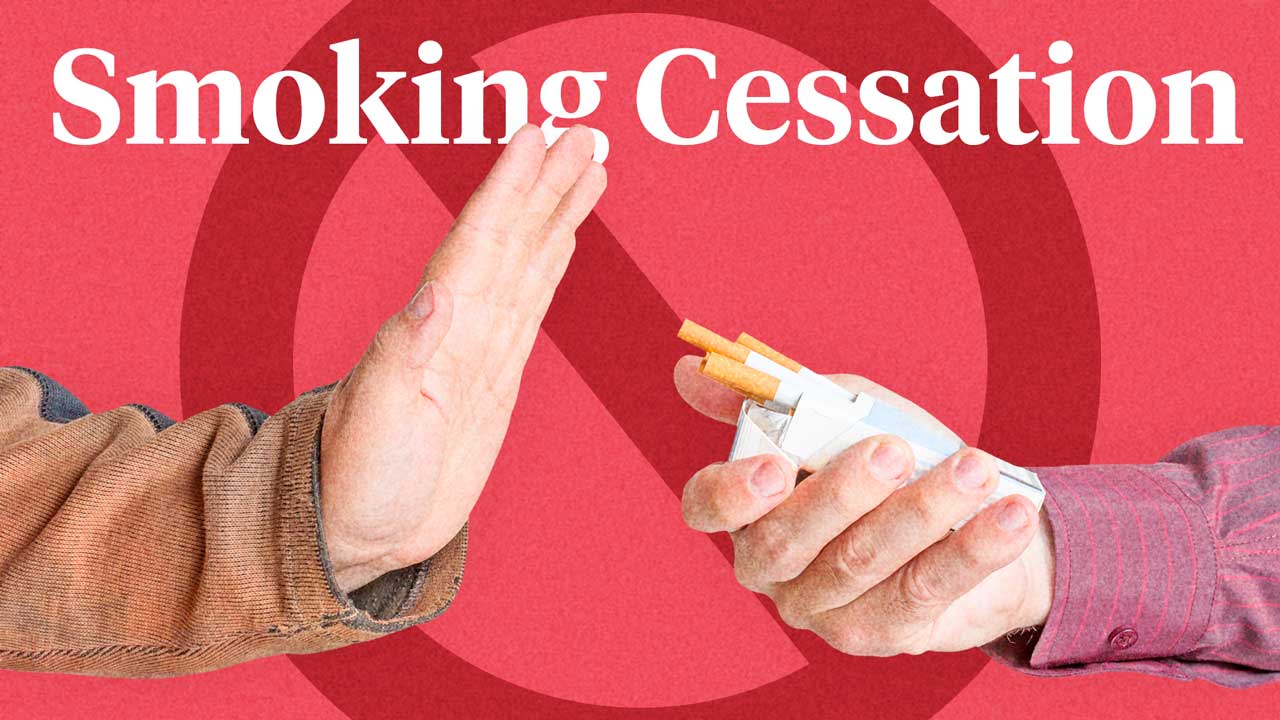With tobacco involved in the deaths of more than 8 million people globally every year (WHO 2023), health professionals play an essential role in supporting people with cessation.
In Australia, tobacco smoking is a major contributor to preventable illness and death. In fact, it’s estimated to contribute to the deaths of over 24,000 Australians every year (Kalitsis et al. 2025).
Smoking cessation - the process of quitting smoking - is imperative to the health of every individual who smokes. Regardless of age or smoking-related conditions that have already developed, there are immediate and long-term health benefits to be gained by quitting (Cancer Council 2019).
Cessation is a difficult process due to the addictive properties of nicotine in cigarettes. Dependence is a chronic condition and those who smoke will experience withdrawal symptoms when they attempt to abstain.
It’s important for anyone embarking on the cessation journey to remember that only a minority of initial cessation attempts are successful, with the average 40-year-old who smokes having made about 20 attempts on average (RACGP 2021). Therefore, a failed first attempt is not necessarily the end, but indeed an important first step on the road to recovery.
The most effective way to attempt cessation is through a combination of behavioural support and medication (RACGP 2021).

Why Attempt Cessation?
Tobacco smoking contributes to the risk of health issues including but not limited to heart disease, diabetes, stroke, cancer, renal disease, eye disease and respiratory conditions (ABS 2022).
There are over 7,000 chemicals in tobacco smoke, more than 70 of which are carcinogenic (capable of causing cancer) (Cancer Council 2019).
In 2024, smoking was attributed to:
- 7.6% of the total disease burden
- 36.1% of respiratory diseases
- 15.4% of cancers
- 5.1% of cardiovascular diseases
- 2.6% of infections
- 1.8% of endocrine disorders.
(Kalitsis et al. 2025)
As well as being directly involved in numerous diseases and health problems, smoking is also a risk factor for a myriad of other conditions including Crohn’s disease, back pain, Alzheimer's disease, sleep disorders, autoimmune diseases and more (Quit 2023).
Smoking and Pregnancy
Smoking during pregnancy can have serious adverse effects on the fetus and contribute to the risk of pregnancy complications (RACGP 2021). These potential issues include:
- Low birth weight
- Being small for gestational age
- Preterm birth
- Perinatal death
- Placental abruption
- Sudden unexpected death in infancy
- Cleft lip and/or palate
- Childhood cancers.
(RACGP 2021)

Passive Smoking
In addition to potential long-term consequences for the smoker, as outlined above, smoking can also cause serious harm to others who breathe in the smoke second-hand and may exacerbate other conditions they have (Better Health Channel 2021).
Second-hand smoke increases the risk of developing lung cancer by 20 to 30%. Infants and children are particularly susceptible to suffering adverse effects from second-hand smoke (CDC 2025).
What are the Benefits of Cessation?
Quitting smoking has immediate effects and will continue to improve the individual’s health progressively over time (DoHaAC 2023a).
- After 12 hours, excess carbon monoxide is out of the system.
- After 5 days, most nicotine is out of the system.
- After one week, the senses of smell and taste improve.
- After one month, skin appearance will likely improve.
- After two months, the lungs are no longer producing extra phlegm.
- After three months, lung function and circulation improves.
- After one year, the risk of heart disease is halved.
- After five years, the risk of stroke is significantly decreased.
- After 10 years, the risk of lung cancer is halved.
- After 15 years, the risk of heart attack and stroke is the same as someone who has never smoked.
(DoHaAC 2023a)
Additionally, evidence shows that quitting may increase an individual’s life expectancy by about 3 to 10 years, depending on their smoking habits and age at cessation. Those who quit before the age of 30 may avoid excess risk of smoking-related death entirely (Greenhalgh et al. 2020).
Cessation will also protect others from the detrimental effects of cigarette smoke.
Methods of Smoking Cessation
These include:
- ‘Going cold turkey’ (stopping smoking abruptly without any further support)
- Gradually cutting down on cigarettes
- Medicines such as varenicline or bupropion
- Nicotine replacement therapy (NRT) in the form of gum, patches, nasal or oral sprays, inhalers, or lozenges and tablets
- Counselling and support services.
(DoHaC 2023b)
Barriers to Smoking Cessation
Identified barriers to cessation include but are not limited to:
- Using smoking as a form of stress relief
- Fear of weight gain after cessation
- Fear of failure
- Nicotine addiction
- Lack of access to support and resources for quitting
- Social pressure
- Socioeconomic disadvantage.
(RACGP 2021; Greenhalgh et al. 2024)
What is the Role of Healthcare Professionals in Cessation?
Healthcare professionals of all kinds play a crucial role in supporting cessation. They should identify clients who smoke and offer advice, treatment or referral for cessation at every opportunity, especially during periods where their smoking habits are particularly problematic (e.g. if they present with smoking-related diseases, if they are hospitalised or if they are pregnant) (RACGP 2021).
The 5As Intervention Method
The 5As are Australian guidelines for health professionals to address and assist with smoking cessation (RACGP 2021).
- Ask all clients whether they smoke and record their smoking status.
- Assess:
- Whether the client has a nicotine dependence by asking questions (e.g. how long after waking does the client smoke their first cigarette?)
- Whether there are any barriers to quitting, and if so, address the barriers with evidence-based strategies.
- Advise the client to quit in a clear, non-confrontational manner. Continue to offer brief, positive reminders.
- Offer to assist the client with cessation and encourage them if they accept.
- Establish a quit plan, suggest strategies and address barriers.
- Assistance may include advice and support, referral or a combination.
- Arrange a follow-up within a week of the client’s designated quitting day to review their progress and address any issues. Monitor any medication and discuss relapse prevention.
(RACGP 2021)

Pharmacotherapy
Healthcare professionals should recommend pharmacotherapy to all clients with nicotine dependence in addition to behavioural support. Medicines used to support cessation are proven to be effective (RACGP 2021).
Refer to the RACGP’s guide for more information on supporting a person’s smoking cessation.
Test Your Knowledge
Question 1 of 3
Ten years after quitting smoking, how much does the risk of developing lung cancer decrease?
Topics
Further your knowledge
References
- Australian Bureau of Statistics 2022, Insights Into Australian Smokers, 2021-22, Australian Government, viewed 25 March 2025, https://www.abs.gov.au/articles/insights-australian-smokers-2021-22
- Better Health Channel 2021, Passive Smoking, Victoria State Government, viewed 25 March 2025, https://www.betterhealth.vic.gov.au/health/conditionsandtreatments/passive-smoking
- Cancer Council 2019, Smoking, Cancer Council, viewed 25 March 2025, https://www.cancer.org.au/cancer-information/causes-and-prevention/smoking/smoking
- Centers for Disease Control and Prevention 2025, Health Problems Caused by Secondhand Smoke, U.S. Department of Health & Human Services, viewed 25 March 2025, https://www.cdc.gov/tobacco/secondhand-smoke/health.html?CDC_AA_refVal=https%3A%2F%2Fwww.cdc.gov%2Ftobacco%2Fdata_statistics%2Ffact_sheets%2Fsecondhand_smoke%2Fhealth_effects%2Findex.htm
- Department of Health and Aged Care 2023a, Why Quit Smoking?, Australian Government, viewed 25 March 2025, https://www.health.gov.au/topics/smoking-and-tobacco/how-to-quit-smoking/why-quit-smoking
- Department of Health and Aged Care 2023b, Quitting Methods, Australian Government, viewed 25 March 2025, https://www.health.gov.au/topics/smoking-and-tobacco/how-to-quit-smoking/quitting-methods
- Greenhalgh, EM, Stillman, S & Ford, C 2020, ‘7.1 Health and Other Benefits of Quitting’, in Greenhalgh, EM, Scollo, MM & Winstanley, MH (eds.), Tobacco in Australia: Facts & Issues, viewed 24 March 2025, https://www.tobaccoinaustralia.org.au/chapter-7-cessation/7-1-health-and-other-benefits-of-quitting
- Greenhalgh, EM, Scollo, MM & Pearce, M 2024, ‘9.9 Are There Inequalities in Access to and Use of Treatment for Dependence on Tobacco-delivered Nicotine?’, in Greenhalgh, EM, Scollo, MM & Winstanley, MH (eds.), Tobacco in Australia: Facts & Issues, viewed 24 March 2025, https://www.tobaccoinaustralia.org.au/chapter-9-disadvantage/9-9-are-there-inequalities-in-access-to-and-usage-
- Kalitsis, L, Greenhalgh, EM & Winnall, W 2025, ‘3.30 Burden of Death and Disease Attributable to Tobacco Use in Australia’, in Greenhalgh, EM, Scollo, MM & Winstanley, MH (eds.), Tobacco in Australia: Facts & Issues, viewed 24 March 2025, https://www.tobaccoinaustralia.org.au/chapter-3-health-effects/3-30-total-burden-of-death-and-disease-attributable-to-tobacco-by-disease-category
- Quit 2023, Deaths & Disease From Smoking, Quit, viewed 25 March 2025, https://www.quit.org.au/fact-sheets/deaths-and-disease-smoking
- The Royal Australian College of General Practitioners 2021, Supporting Smoking Cessation: A Guide for Health Professionals, RACGP, viewed 25 March 2025, https://www.racgp.org.au/clinical-resources/clinical-guidelines/key-racgp-guidelines/view-all-racgp-guidelines/supporting-smoking-cessation
- World Health Organisation 2023, Tobacco, WHO, viewed 24 March 2025, https://www.who.int/news-room/fact-sheets/detail/tobacco
 New
New 

